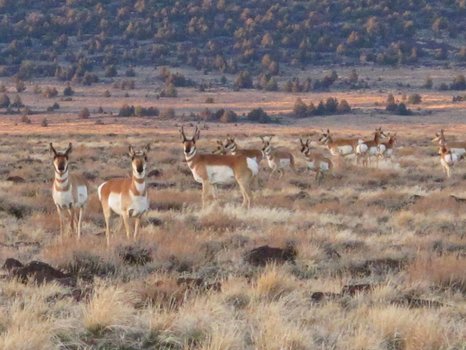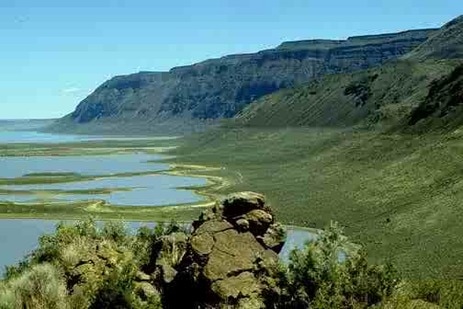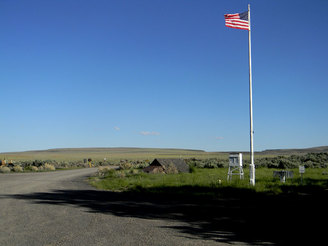About Hart Mountain National Antelope Refuge
 Photo by Jesse A. Laney
Photo by Jesse A. Laney
“Those who visit Hart Mountain next century will know that we were faithful life tenants, that we did not entirely despoil the earth which we left them. We will make the tradition of conservation as much a part of their inheritance as the land itself.”
- U.S. Supreme Court Justice William O. Douglas.
My Wilderness, 1960.
Hart Mountain National Antelope Refuge was established in 1936 as a place for the disappearing pronghorn antelope. Today, Hart Mountain is managed by the U.S. Fish and Wildlife Service. The refuge is about 20 miles wide and 40 miles long and is located at the northern end of the Great Basin desert in southeastern Oregon, 65 miles northeast of Lakeview. It is now the summer home to upwards of 8,000 pronghorn antelope.
Like other mountain ranges in the Basin and Range, it is in part of a ‘sagebrush sea’ with northwest trending mountain ranges interspersed with seasonally wet basins. Similar to Steens Mountain to the east, Hart Mountain is a fault scarp, tilted up on the west side, with a 3,500 foot escarpment that drops precipitously down into the Warner Valley.
Heading east from Warner Peak, at over 8,000 feet, the landscape changes from peaks to broken ridges and ledges covered with sagebrush and grasses gradually sloping to the southeast into seasonal lakes and ultimately into the Guano Basin. Annual precipitation averages 12 inches, primarily in the form of winter snow and spring rains. The temperature varies from Midwestern cold in the depth of winter to very hot and dry in the summer.
- U.S. Supreme Court Justice William O. Douglas.
My Wilderness, 1960.
Hart Mountain National Antelope Refuge was established in 1936 as a place for the disappearing pronghorn antelope. Today, Hart Mountain is managed by the U.S. Fish and Wildlife Service. The refuge is about 20 miles wide and 40 miles long and is located at the northern end of the Great Basin desert in southeastern Oregon, 65 miles northeast of Lakeview. It is now the summer home to upwards of 8,000 pronghorn antelope.
Like other mountain ranges in the Basin and Range, it is in part of a ‘sagebrush sea’ with northwest trending mountain ranges interspersed with seasonally wet basins. Similar to Steens Mountain to the east, Hart Mountain is a fault scarp, tilted up on the west side, with a 3,500 foot escarpment that drops precipitously down into the Warner Valley.
Heading east from Warner Peak, at over 8,000 feet, the landscape changes from peaks to broken ridges and ledges covered with sagebrush and grasses gradually sloping to the southeast into seasonal lakes and ultimately into the Guano Basin. Annual precipitation averages 12 inches, primarily in the form of winter snow and spring rains. The temperature varies from Midwestern cold in the depth of winter to very hot and dry in the summer.
 Photo copyright 2006 by William L. Sullivan, author of "100 Hikes/Travel Guide: Eastern Oregon." Used by permission.
Photo copyright 2006 by William L. Sullivan, author of "100 Hikes/Travel Guide: Eastern Oregon." Used by permission.
The refuge is home to over 340 species of wildlife. In addition to pronghorn (antelope), large mammals including elk, bighorn sheep, mule deer, and mountain lions inhabit the refuge. Since 1995, there has been no livestock grazing on the refuge. The refuge is dominated by sagebrush and grasses, but the high quality sage steppe landscape includes dry and wet meadows, riparian aspen and willow stands, juniper, mountain mahogany and snowpocket aspen groves in the higher elevations. Because of the quality of the vegetation, Hart Mountain is considered a critical habitat for Greater Sage-Grouse recovery efforts.
As a part of the U.S. National Wildlife Refuge system, Hart Mountain it is managed primarily for the benefit of wildlife. However, there are established campgrounds in the Warner Valley, at the hot springs, in Guano Valley and a horse camp at Post Meadows. You can explore much of Hart Mountain in a low clearance vehicle, traveling to the hot springs, campgrounds or Blue Sky, a remnant ponderosa pine forest. There are few designated hiking trails and the best way to explore Hart Mountain is to simply walk up a canyon, along a stream or out across the sagebrush ‘ocean’. You can also drive to see petroglyphs left by native people at Petroglyph Lake and abandoned structures from the homesteading era at the Flook Ranch.
Whether you are looking for solitude, soaking in the hot springs, camping with family and friends, observing wildlife or hunting, Hart Mountain is a fantastic place to enjoy the freedom of wide open spaces, explore America’s public lands and watch the antelope play.
As a part of the U.S. National Wildlife Refuge system, Hart Mountain it is managed primarily for the benefit of wildlife. However, there are established campgrounds in the Warner Valley, at the hot springs, in Guano Valley and a horse camp at Post Meadows. You can explore much of Hart Mountain in a low clearance vehicle, traveling to the hot springs, campgrounds or Blue Sky, a remnant ponderosa pine forest. There are few designated hiking trails and the best way to explore Hart Mountain is to simply walk up a canyon, along a stream or out across the sagebrush ‘ocean’. You can also drive to see petroglyphs left by native people at Petroglyph Lake and abandoned structures from the homesteading era at the Flook Ranch.
Whether you are looking for solitude, soaking in the hot springs, camping with family and friends, observing wildlife or hunting, Hart Mountain is a fantastic place to enjoy the freedom of wide open spaces, explore America’s public lands and watch the antelope play.
Where is Hart Mountain?
|
Directions
From Lakeview, where Hart-Sheldon Complex Office is located: 20995 Rabbit Hill Road, Lakeview, OR 97630, take US Highway 395 North about from Lakeview about 5 miles. Turn right on Oregon State Highway 140 and go east 15 miles, then turn left at the sign to the Refuge. Go 19 miles to Plush and continue through Plush about 1 mile then turn right at Hart Mountian Road. Follow the Hart Mountain Road to the Refuge Headquarters (The view of Warner Valley on the road up the mountain escarpment is quite dramatic). From Malheur National Wildlife Refuge (NWR), go south on Oregon State Highway 205 through Frenchglen, and continue another 10 miles, then turn west (right) at the sign to the Refuge and travel 36 miles to the Refuge Headquarters. For more information about road conditions contact: Hart Mountain NAR, 38782 Hart Mountain Rd, Plush, OR 97637. Phone (541) 947-2731. |
© 2005-2023 Friends of Hart Mountain - All Rights Reserved.

